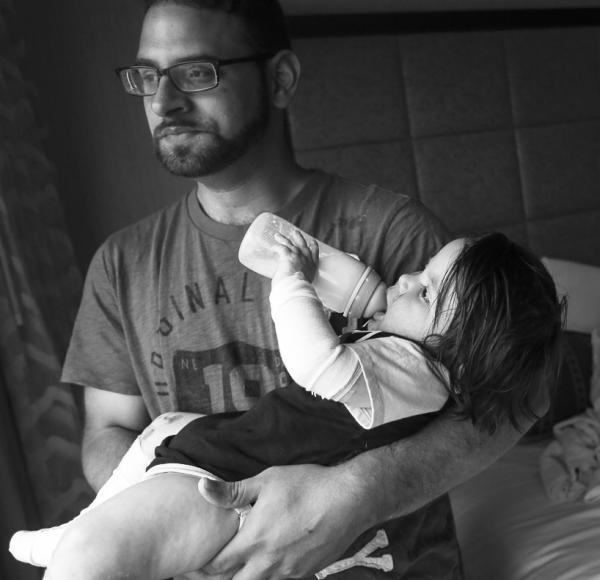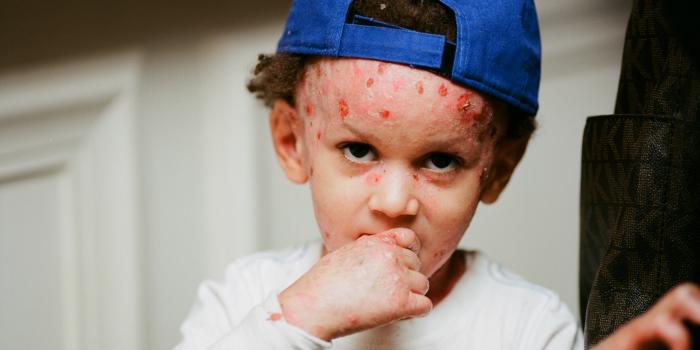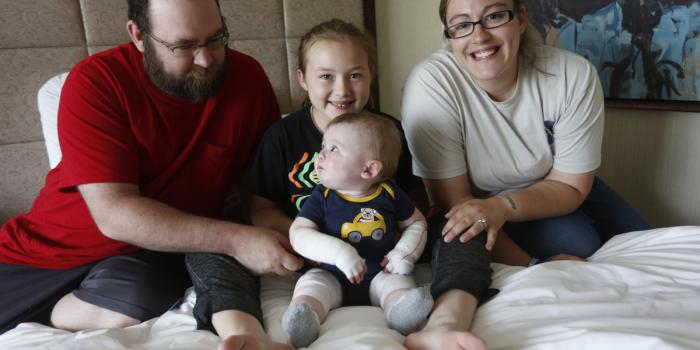
*CLICK HERE TO DOWNLOAD A PDF VERSION OF THIS PAGE.
Parents of a child with Epidermolysis Bullosa (EB) are encouraged to develop a relationship with an occupational or physical therapist in your area.
Not every child with EB will need therapy throughout their life, but it is good to have someone to contact if there are concerns regarding motion, strength, or loss of function. It may be helpful to take pictures of open sores to show your therapist if your child is wrapped during sessions. This will help them to learn how best to treat your child.
Services provided by occupational therapists for those with Epidermolysis Bullosa (EB) include upper extremity range of motion and strength, hand splint/orthotic fabrication, fine motor skills, independence in self-care, independence in activities of daily living and assessments for use of durable medical equipment (bath chair, wheelchair, etc.).
Services provided by physical therapists for those with Epidermolysis Bullosa (EB) on the other hand include lower extremity range of motion and strength, gross motor development skills, assessment of lower extremity orthotics and assessment for use of durable medical equipment, such as crutches and wheelchair systems.
The information below is intended to give parents and care providers an overview of the common areas that occupational and physical therapists are asked about. Occupational Therapy and Physical Therapy is different for every child, and each child’s treatment plan is highly individualized and tailored to their individual physical, intellectual and social-emotional abilities.

Give your baby daily opportunities for belly time, crawling, and cruising. Watch for potential blisters and bandage as needed for protection. When playing on the floor, use foam blocks for comfort and decreased friction, however, care should be taken to not make the surface too soft that it is difficult for your child to move. Teach family members and caregivers how to pick up your child appropriately so they don’t cause unnecessary harm to your child.
Find a balance between wrapping the baby’s hands to maintain web spaces and allowing him/her the freedom to explore the surroundings. Early on, the baby will want to put their hands into their mouth. If there isn’t skin breakdown, this is an important activity to increase the sensory input into both the mouth and the hands. If there is skin breakdown, consider provision of teething toys for oral exploration and wrapping between the web spaces but allowing fingers to be free.
It can be beneficial to wrap hands to help preserve the web space between the fingers and the thumb. Do not over wrap the fingers as this can limit movement and sensation. Make sure that you keep the web space between the thumb and index finger as wide as possible. This can be done by doubling up on Mepitel and wrapping like a figure 8.
Splinting may be considered for night time use at elbows, wrist, fingers, knees and ankles to help prevent contractures. Splinting should be used when no direct pressure will be placed on blisters. Speak to your therapists for ideas to provide soft padding. Another option is to ask your OT about using a silicone-based putty called elastomer to make a small web spacer splint to wear along with bandages at night.
Serial casting may also be an option for children with simplex or RDEB. The protocols are different for each and can be obtained on request. It will be necessary to find a PT who is knowledgeable about serial casting.
Assess orthotics and splints at least every 6 months as they may require adjusting to ensure patient compliance with use. Consider a flexible wearing schedule by alternating days or alternating joints.
Try to make stretching part of the everyday routine to help preserve mobility and flexibility. Good range of motion or stretching exercises may help to limit contractures. Be proactive to maintain the mobility, but always go very slow. If there are major sores, wait until they are not as painful to address these areas.
As the child is able, teach them to do their own stretches. They will be more compliant if they do the stretch versus having someone else stretch them. Keep stretches simple and prioritize the exercises. Do two to three stretches daily and prioritize the areas where blisters cross the joints.
Also, keep your child involved in typical activities such as walking, dancing, riding a bike, swimming, and yoga. This will help to continue to develop their muscles and is good for social development as well. Have a goal in mind of 30 or more minutes per day of physical activity.
A padded bike seat may be beneficial. Try to have a variety of activities that include going outdoors and interacting with others. Having a family pet is often motivating and fun.
- In early childhood, use distraction (like entertainment – singing songs, TV/DVD’s, books, etc.) to help with stretching/exercise program.
- Some kids benefit from the use of a reward system for completing their exercises/stretches. One example is a sticker or a reward chart for each day the child completes their exercises, with a larger reward when the child fills the chart.
- Try to make your home exercise program part of your daily routine.
- Don’t be overprotective. Let kids be kids safely.
- Don’t allow behavior you wouldn’t allow your other kids to do. It is easy to overlook bad behavior because our EB kids are “special”. But if we want them to be accepted by others, we need to teach them to be as independent as possible and as kind and cool as possible.
Credit: Susan Maksomski, OTR/L, CHT, Morgan Stanley Children’s Hospital, Amy Weisman, PT, DPT, Lucile Packard Children’s Hospital at Stanford, Jennifer Chan, OTR/L, CHT, Lucile Packard Children’s Hospital at Stanford. This information was presented at the 2016 debra Care Conference.
More Guides
Improving Participation in Daily Activities for Children Living with EB
Patient Guide for Adults with EBImproving Participation in Daily Activities for Adults Living with EB
Occupational Therapy for EB: Clinical Practice Guidelines Physiotherapy for EB: Clinical Practice GuidelinesPhysiotherapy for Epidermolysis Bullosa: Clinical Practice Guidelines
*Please note that all medical information given by debra of America is for informational purposes only. Our information is not intended to substitute the care and guidance given by a qualified physician. All regimens of care should be discussed with the patient's occupational or physical therapist. Always check with your physician prior to starting any medications or treatment regimens.






